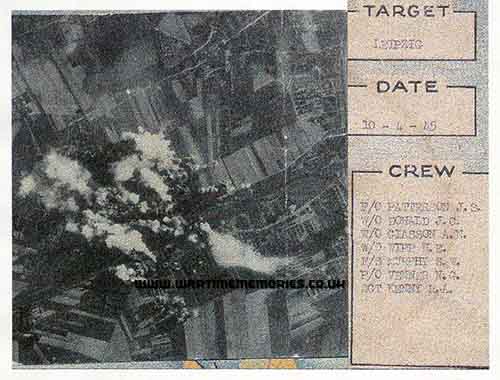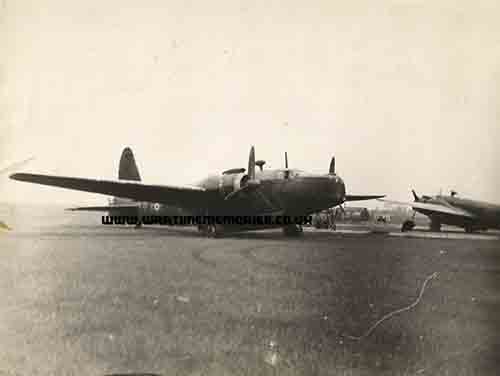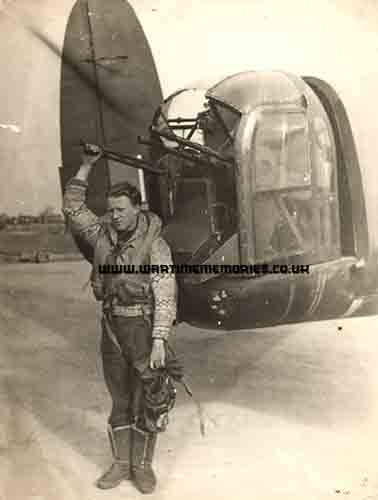P/O. Stewart W. Murphy
Royal Canadian Air Force 431 Squadron
from:Calgary, AB
Target Hamburg by Stewart W. Murphy, Former Pilot Officer, Rear Gunner 431 (Iroquois) Squadron R.C.A.F. Stationed at Croft, Yorkshire, England.
One of my most memorable operations was a so called routine raid on the Hamburg submarine pens, 31st of March 1945. Although, it started out as a routine day, it would grow progressively worse. The weather was deteriorating fast. We would have to bomb on H2S radar through heavy clouds. To further complicate things, our fighter escort was late and would not get there in time of the bombing run, our most vulnerable time.
As was usual on all of our trips, the crew would report to the Navigator anything that appeared unusual, just to pass the time. An unusual situation was developing far to our rear. I could just make out what looked like a bomber blowing up. It seemed like several minutes, but it was really only seconds before I could make out what looked like a twin engine fighter off our starboard rear quarter. It appeared several hundred yards off, streaming past the bombers to our rear. It was not one of our escorts. In the last few minutes I recognized it was a ME262 jet. It was a real surprise, we had never seen on before! I calmly raised my voice and asked the Pilot to corkscrew to starboard. I let off a short burst with my four Browning 303's which caught the jet full on to its port engine. The jet just blew up as it peeled over into the clouds. I reported what happened and we resumed our normal course. A few seconds later my racing thoughts were interrupted by the mid-upper gunner. He cried, "There's another one coming in higher from the rear." We dived again to the starboard and we let loose with all of our guns. The fighter seemed to just hang there for a second before the cockpit and port engine exploded.
Blowing "something" out of the sky can be described as a strange marriage of excitement, fear and disgust. That "something" had once threatened our aircraft. It could have very easily been our aircraft going down in flames. I continued to count the bombers blowing up as we left the target area. It was later confirmed that we lost 21 Lancaster and the Germans lost 26 fighters. It was a staggering loss on both sides. Most of the German fighters were shot down by our tardy fighter escort. They used their favorite method of following the much faster jets back to their base and would then catch them with their wheels down when they came in to land. The German fighters were DEAD DUCKS before they knew it! We claimed two fighters that day. They gave us one and one-half (we had to share the second one with another Lancaster crew).
Authors note:
The R.C.A.F. flew Lanks, Hallys, & Wimpys out of #6 Canadian Bomber Group in Yorkshire, England. We flew mostly night raids, so our formations (or lack of one) was totally different than the boys in the Libs and Forts. We flew in what was known as a gaggle (as in gaggle of geese). Each aircraft was on his own, flying at predetermined heights, usually spread between 17 and 20 thousand feet; arriving over the target rather strung out. At night we were one of many hundred aircraft sharing the sky. Often the only aircraft you would see was one of ours going down. It would light the sky for a minute, then we were back to that black anonymity of being alone again... or so you hoped.
About the photographs.
I did 32 operations in this Lanc as Tail Gunner. She flew 61 missions before she was flown home to be part of the Tiger Force, which was being formed to take part in the Pacific war. I flew 18 missions on her and 13 on Halifax Bombers as Tail Gunner. I had several "interesting" trips in both types. One of the most "interesting" raids was on Hamburg where we were attacked by 90 JU88s and the, then new, ME262s. My mid-upper gunner and myself shot down two ME262s, all told we lost 21 Lancasters they lost 26 fighters.
In the picture of the turret, you can see the front perspective plastic has been removed, leaving the tail gunner open to the elements. Although, this gave us much better visibility, it also made it very cold. When flying 18,000 to 20,000 feet, it was often 40 or 50 degrees below zero outside. We were bundled up in four layers of clothing, including an electric suit (that came with electric gloves and slippers). The main drawback to this was the fact you worked up a sweat before take off, so when you plugged in you usually got zapped with a shock. This made you put off plugging in until you were damn near frozen.


